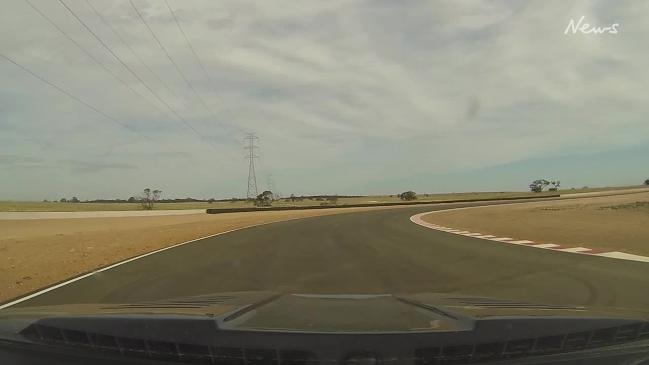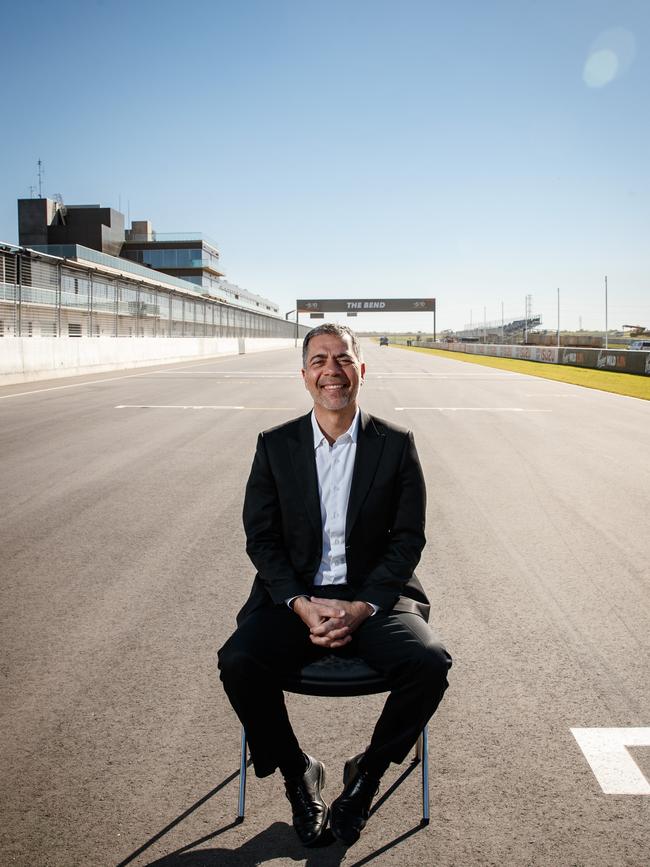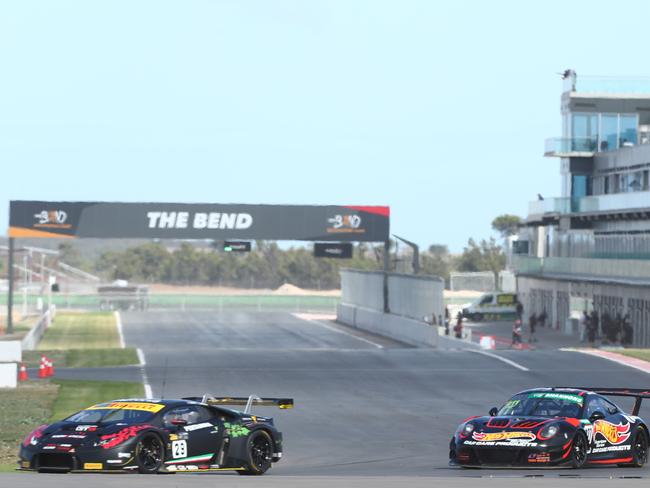Supercars about to roar into Tailem Bend
MANY shook their heads when Sam Shahin announced plans to build a world-class racetrack on paddocks 100km from Adelaide. But the petrol baron’s “build it and they will come” philosophy is paying off with the Supercars about to roar into Tailem Bend
TAILEM Bend is about to be redefined. By the end of the month, it will no longer be considered just another obscure dot on the rural map, sleepy and boring. Instead, tree changers and hobby farmers will shun it, farmers will moan that chickens won’t lay, wool won’t grow and cows won’t milk, and it will become a year-round magnet for grey nomads and motorsport addicts.
That’s because the town, 100km southeast of Adelaide, is now home to the premier motorsport venue in Australia – and set to become one of the most visited places between Adelaide and Melbourne. As of next Friday, the $160 million The Bend Motorsport Park will no longer be the topic of idle barbecue conversation but host to the nation’s premier motorsport event, a round of the Supercars series which each year thrills fans (and drives detractors nutty at the Adelaide 500 venue).
The Supercars will arrive for the first time in a five-year deal with an ear-shattering roar equal to hundreds of oncoming freight trains, along with an eye-watering explosion of colour on the track. A hoped-for crowd of 50,000 will watch numerous back-up events from August 24-26, headlined by a 120km Supercars race on the Saturday and 200km on Sunday. Around the country, many thousands more will be glued to live Fox Sports TV coverage or Channel 10 highlights.
Even for the bloke who made the idea come to life, Sam Shahin – son of a refugee, a medical doctor, businessman, Porsche Carrera Cup race car driver and dreamer – it hasn’t quite sunk in yet.

“Every time I visit it, I just walk around (The Bend) with a big grin and I just have to pinch myself to believe this is actually real,” he says.
But it is. And more people will soon know what and where Tailem Bend is than at any time since it was established.
Until now, with a population of 1665 at the 2016 census, the town more than met parts of the “sleepy” country stereotype, certainly compared to the 400,000 annual visitors who the Coorong District Council expects will now descend annually.
It’s been seen as a River Murray backwater, despite its picturesque setting perched atop high cliffs on a wide bend of the river. Tailem Bend was first a fishing spot for the Ngarrindjeri indigenous community – “thelim” meaning “bend” or “Thelum Ki” which means bent water – and then in 1884 a camp for railway workers building the line to Victoria.
The area’s farms, the Adelaide-Melbourne railway, Adelaide-Melbourne highway, Coorong Council HQ, and a River Murray cable-ferry crossing have been enough to keep the town off life support for decades. All that is now changing rapidly, with an increase in consumer spending brought on by The Bend, measured by NAB, of 13.5 per cent in just one quarter this year. Accommodation bookings are the best non-farming measure to gauge the health of a regional community, and in the weeks around the Supercars event, beds are booked out for 50km around. This is despite the track itself having a 100-bed, four-star Rydges Hotel on site, and 600-plus camping and caravan sites. The hotel is full, as are around three quarters of the campsites. The annual trickle of August tourists has turned into a torrent and, more than a month ago, revheads were already booking in Adelaide an hour away, happy to commute for the three-day event.
Landlords and ladies are charging prices befitting of their new status. Coorong Realty owner Kerry Symcock, based in Tailem Bend, says riverfront homes are rented for up to $1000 a night. Symcock says, by way of comparison, if a rental was available for $300 per night in the off season, this would rise to $600 in the high season. But for the weeks around the Supercars event this has increased to $900, or a 200 per cent increase in the rate at this time of year.
“The only things that we haven’t booked are some boutique places right out along the Coorong,” she says. “As soon as something is put online, it is snapped up.
“In the overall area in recent years, we have grown from 200 available beds, up to 400 during building with The Bend and the solar project, and now about 600. We are organising homestays now, this year, where mum and dad and kids will go off to the Gold Coast for that weekend and rent out the house to pay for the holiday.”
Even at this late stage, some additional accommodation is coming on to the market as residents learn about the fast money that can be made, she says.
Regional tourism development manager Julie Bates can cite numerous examples of how The Bend is already shaping the future of the area.
The Riverside Hotel is using a $200,000 State Government grant to develop outdoor dining along the extraordinary clifftop views of the Murray that Tailem Bend is known for. Capacity for outdoor dining will increase from 16 seats to 80 seats, seven jobs will be created during construction and seven full-time jobs afterwards.
“Each week, I hear from our tourism operators about innovative ways they’re stepping up their business game, to leverage from the thousands of people who will visit this facility each year,” Bates says. “Everything from accommodation growth, new catering packages, transport services, meal offerings, recreational trails, boutique coffee shops, tour-bus services, even a quality fish-tasting tour down in the Coorong.”
The boom has had a rapid gestation, beginning in February 2015, when Peregrine Corporation lodged plans with the State Government to redevelop what had been the Mitsubishi Motors Australia test track.
At the heart of The Bend Motorsport Park is an extraordinary 7.77km-long circuit which rivals any in the world up to – but not including – Grand Prix standard. A round of the MotoGP, pinnacle of the motorcycle racing world calendar, is possible, and if rumours are to be believed, the Le Mans car series as well. The glamour events will bring the crowds, but what is winning the hearts of the Australian motorsport community is the attempt by Shahin to cater for every aspect of the sport, not just the high-end entertainment the Supercars bring.
The Bend wants everyone from the weekend warrior taking driving lessons on its 40ha four-wheel-drive track to Japanese-inspired drift car racers, 9000 horsepower dragsters and tiny go-carts. Beginning with minor events in January this year, bookings can already be measured in the dozens. Even the 25th Australian Jamboree for Scouts Australia will call the circuit home for next year’s event.
It doesn’t take much for “Dr Sam”, as the workers call Shahin, to stray away from the high-end aspects of the development to the more mundane. But the pride is no less evident: “Fans can also experience trackside camping. It’s popular with just under half of the 600-plus sites booked within less than a week of going on sale.”

The breadth of the offerings and the acceptance of all comers suggest the humble beginnings of the Shahin family – who came to Adelaide after fleeing war-torn Palestine – have been etched into the fabric of the park. “This has always been about giving something back to South Australia, which we are so appreciative for,” Shahin says.
The canny Shahin family also knows that the breadth of offerings at The Bend is also their point of difference with the Adelaide 500. The facility takes Aussies back – in spirit at least – to the origins of their motorsport, in which half-crazed petrolheads would carve out a circuit in the middle of a paddock with a dozer and a dream. At The Bend, fans can use park-and-view sites around the track to reverse their utes up to the safety fence.
The success of The Bend will not mean it replaces the Adelaide 500. The Adelaide/Clipsal 500, with crowds approaching 300,000 during the heyday of its 20-year history, has become Adelaide’s most successful party weekend.
But along with that have come tens of thousands who would not know the difference between a tie-rod and a tyre, or a carburettor and a cam shaft.
Many are there for the concerts, the corporate boxes, the displays and the celebrity. Most of the expected 50,000 people at The Bend for the supercars will be there for the cars and the track. On the plus side, they will pay as little as $69 for a Supercars race-day ticket, instead of more than $100.
A distracted Shahin is eager to highlight the price difference. He has squeezed one last photo shoot at the track for us. He has returned to Australia days before the main event, and is dividing his time between making sure there are no last-minute disasters to deal with, and finding out during testing if he has recovered well enough from back surgery to wrangle his Porsche around the circuit on race day.
He once again views the track from his favourite spot, the top of the five-level 100m-long main pit and hotel building where spectators can see the entire circuit. Shahin surveys a sea of green grass, where only months ago was troublesome dust.
The circling grass slasher belies the dust storm which beset a GT event at the circuit earlier this year, and a push last summer by the Supercar series owner for a mass grass seeding campaign. But the Shahin family is used to dealing with adversity. ¬
The family story in SA is now well-known. Led by father Fred, the migrants established The Bend parent company Peregrine Corporation in 1984. It has grown from a single family-operated petrol station in a western Adelaide suburb to more than 130 stations/convenience stores branded as On The Run and now OTR. Peregrine is now one of the top 15 private companies in Australia and the largest private company in SA.
Sam Shahin is known as a hands-on boss. But for the day-to-day, he is aided by one of the nation’s most capable motorsport administrators. For track boss Mark Warren, every feature of this sprawling, multifaceted facility is seared in his memory, despite the looming V8 race taking most of his time.
In 2010, Warren was made the CEO of the South Australian Motor Sport Board, putting him in charge of running the then Clipsal 500 event. He was headhunted by the Shahin family to develop and run The Bend in 2016, when it was nothing more than 680ha of undulating, marginal grazing land at the convergence of the Dukes and Mallee highways. By comparison, the site is just smaller than the current size of the Adelaide Park Lands.
Warren can itemise every aspect of The Bend: Go-karts, rally circuit, a holiday park, an airstrip for planes up to 10 seats, helipads, a vehicle testing strip and an On The Run outlet complete with fast food franchises like Krispy Kreme. Yet the project is still only half complete. Work on the drag strip will begin early next year. Forty hectares has been set aside for an industrial precinct of 50 individual allotments ranging from 2000sq m to 20,000sq m.
Warren knows the hard part is done. Laying thousands of tonnes of road base and bitumen on a platform carved out of limestone lying just beneath a thin layer of sandy topsoil has not been an easy task. The rock is the perfect immovable object to plant a motorsport circuit on, but it has also caused the greatest challenge. Even shallow trenches for infrastructure have to be carved into the limestone. But as well prepared as he is, some things still give him nightmares. “In the back of my mind always is what I call the Bathurst moment when kangaroos go bounding across the Supercars track while the cars are going around,” Warren says.
The main building itself began like a mirage, but is now undergoing finishing touches. A visitors’ centre where passers-by can sip coffee next to multi-million dollar historic vehicles is already attracting many visitors, mainly tourists stopping to see what the fuss is about. The centre is already on the retiree bus tour itinerary, especially coming from Victor Harbor.
The Bend is designed as a motorsport playground, not just a venue for gladiatorial battles between the sport’s elite drivers. An agreement with the National Motor Museum at Birdwood means a rotation of six historic vehicles are always on show. A priceless, privately owned Porsche 962 Le Mans vehicle currently takes centre stage, along with a Ferrari estimated to be worth $3 million, at the visitors’ centre, which is also fully licensed to sell vehicles in the future.
So far, wealthy car enthusiasts are lining up to show off their prized possessions to an appreciative audience, rather than collecting dust in sheds around the country.
In future, the rich and famous will be able to house their historic F1 car or other beast at the circuit – possibly in their “man cave” underneath one of 400 trackside homes specially designed for the purpose – and take it out for a spin on weekends.

The first stage of 42 homes has already been sold via expressions of interest. It will be the only place in Australia where such playtime can happen at a track licensed by the Fédération Internationale de l’Automobile (FIA) for car racing and the Fédération Internationale de Motocyclisme (FIM) for motorcycle racing. The man caves are attracting international attention, especially in South-East Asia.
If the rich and famous are lucky, they will rub bumpers with the world’s latest supercar, the $1.8 million Brabham BT62, to be built and tested in SA partly as the result of the opportunities offered at The Bend. Several mainstream car manufacturers have also expressed interest in vehicle launches and television commercials at the venue.
One V8 race team will make their headquarters for the Supercars event a string of 14 houseboats along the river. However, suggestions that the bend of the river may become a water playground, and one for high-end water sport events, may fall foul of locals.
There have already been local grumbles, with noise and dust being the most common. Coorong District Council mayor Neville Jaensch seems to reflect the majority view, a collective basking-in-the-reflected-glory of what he calls a “tsunami of change”, as well as welcoming investment in infrastructure upgrades, businesses and especially accommodation. “We’ve gone in the last few years from a sleepy council that sits in the back row of the meeting. Thanks to the motorsport park, we are now sitting in the front row,” he told one journalist.
Warren says most locals appreciate what has been brought to the area, with secure local employment being the most commonly cited. Three hundred employees will be needed to put the Supercars event together, along with 300 volunteers. “We have a community consultation person staffing a hotline during events so people can call in and we can respond to that. We can’t stop racing but there are many things that can be done, like putting in place curfews to limit noise,” he says.
“The fact that we have a hotel on site means that there is self-interest there for us as well. In terms of jobs, it is continuous because people start in casual roles and move on either to full time or to other jobs.”
What makes The Bend extraordinary is the sheer scale of the project, and the fact it is almost entirely privately funded. The most recent permanent motorsport circuit in Australia was built almost 20 years ago. But unlike similar-sized investments in the business world, there is no guarantee of profits in the sports venue business, or even revenue.
While many structures built at a cost of $160 million have a guaranteed rental income, manufacture a product to sell, or have the surety of government backing, the Bend has none of these. It is a massive punt which so far has and will make a lot of noise, but may never turn a dollar. And all built with only a $7 million spend by the taxpayer for infrastructure upgrades on government land.
But it is not the first time the Shahins have backed themselves in bold business ventures. Just a few years ago, Sam Shahin was photographed in an empty paddock of red dust. Many no doubt thought his promised circuit would never happen – or, if it did, nobody would be bothered going to Tailem Bend to use it. The growls of the Supercars next week is evidence the naysayers were wrong. Shahin’s “build it and they will come” dream has become a reality. ●
